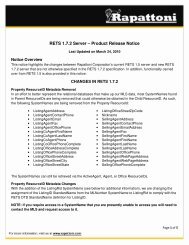Specification - RETS
Specification - RETS
Specification - RETS
Create successful ePaper yourself
Turn your PDF publications into a flip-book with our unique Google optimized e-Paper software.
<strong>RETS</strong>-Request-ID The contents of the <strong>RETS</strong>-Request-ID header, if any, sent by the<br />
client in the request. If a <strong>RETS</strong>-Request-ID is included in a<br />
request from the client then the server MUST return it in the<br />
response.<br />
<strong>RETS</strong>-Request-ID ::= 1*64ALPHANUM<br />
Server<br />
The server standard response-header field contains information<br />
about the software used to handle the request. The format of this<br />
field specified in RFC 2616 Section 3.8.<br />
Example: Server: Microsoft-IIS/4.0<br />
<strong>RETS</strong>-Server The <strong>RETS</strong> server vendor and server-controlled version number.<br />
This is not necessarily the same as the Server response-header<br />
field; it will be different if the HTTP server is separate from the<br />
<strong>RETS</strong> server. The format of this field is specified in RFC 2616<br />
Section 3.8.<br />
Example: <strong>RETS</strong>-Server: Acme<strong>RETS</strong>/1.0<br />
Set-Cookie<br />
The server MAY use HTTP cookies to maintain state<br />
information. See RFC 2109 for the format of the Set-Cookie<br />
header.<br />
A cookie having a name of <strong>RETS</strong>-Session-ID defines the <strong>RETS</strong><br />
session ID, which is used in calculating the <strong>RETS</strong> User-Agent<br />
Authentication (section 3.10). Cookies with other names have no<br />
special meaning in <strong>RETS</strong> but MAY be used when necessary.<br />
In addition to the header fields listed here, the server may send any header compliant with<br />
HTTP 1.1.<br />
3.8 Data Compression in <strong>RETS</strong> Transactions<br />
Clients and servers may choose to support data compression in data returned from the<br />
server. To indicate its willingness to accept compressed data, a client includes an<br />
Accept-Encoding header in its request. If the server supports one of the compression<br />
methods accepted by the client, it can include a Content-Encoding header in its response<br />
indicating the compression method it has chose.<br />
Clients and servers choosing to implement compression SHOULD at least support GZip<br />
compression. This method is implemented by freely-available source code in a number of<br />
languages, as well as in several proprietary software development environments. A second<br />
freely-available alternative is BZIP. Clients and servers are free to choose other encoding<br />
methods as well.<br />
Version 1.7.2 3-7




